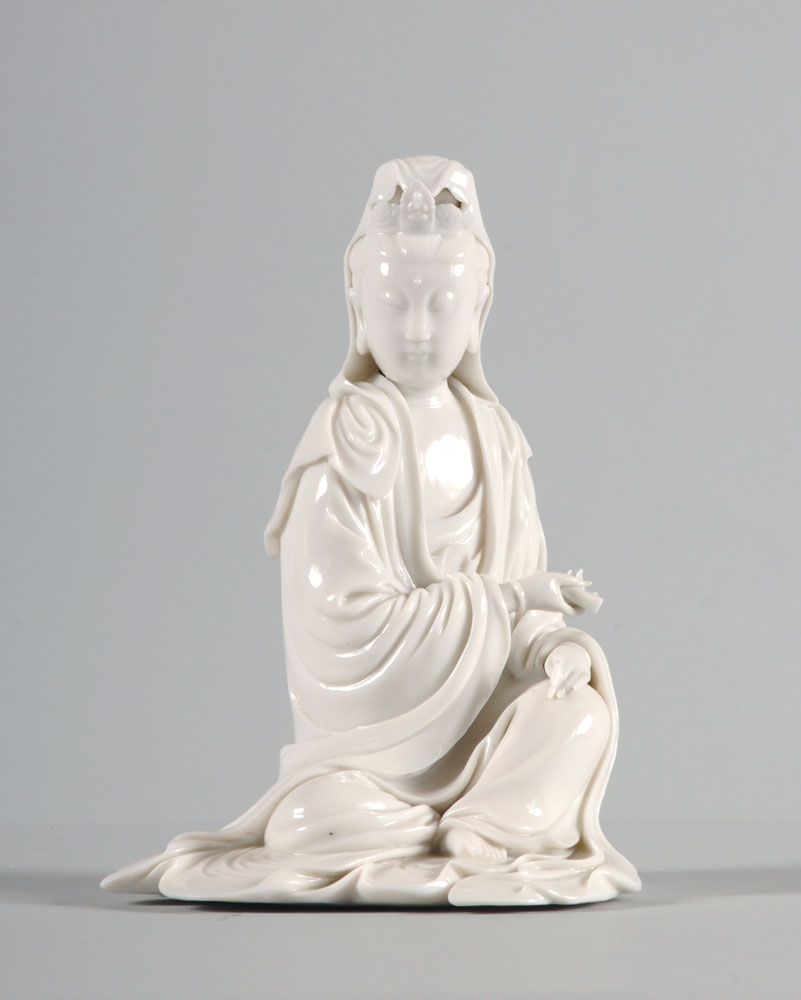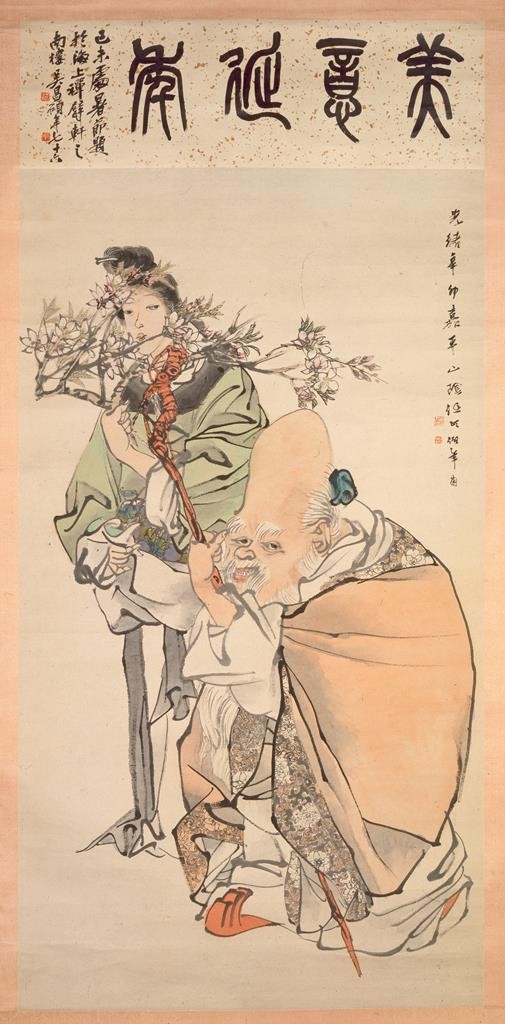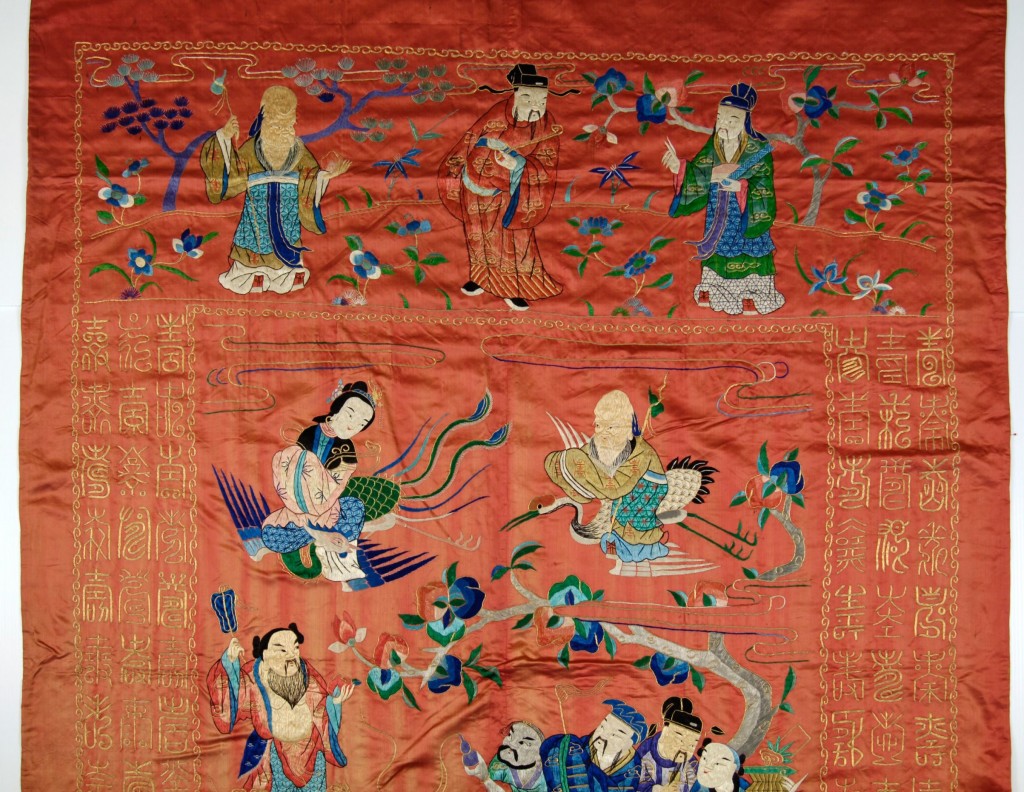This wide-ranging exhibition, which includes paintings, textiles and porcelain, takes Chinese immortals and immortality as its theme. With a particular focus on the Pure Land of Amitabha Buddha – the Buddha of Infinite Light – the exhibition also explores the worlds of Daoist Immortals and the Queen Mother of the West, all of whom had their mythical homes beyond the boundaries of the mortal world.

LI1301.398 Bodhisattva Guanyin, China, 18th-century, Blanc-de-Chine porcelain, 22 x 16.7 x 14.5 cm, Lent by the Sir Alan Barlow Collection Trust © The University of Sussex
The Queen Mother famously makes an appearance in the Ming dynasty novel Monkey (Journey to the West) by Wu Cheng-en (1501-1582), and in this Year of the Monkey the mischievous antics of the Monkey King, Sun Wukong, stealing the peaches of immortality from the Queen’s peach garden, are represented in the exhibition by the paintings of Zheng Jiazhen (1918-2000). In his work Zheng is able to cleverly blend the worlds of the cartoon and traditional Chinese painting; here with depictions of the Monkey King as a character in Chinese opera.
Although in the teachings of Mahayana Buddhism other pure lands do exist, for example the Pure Land of the East of the Akshobhya Buddha, it is Amitabha’s Pure Land of the West, Sukhavati, that is the most popular and has received most attention in the world of art and literature. Pure Land is a form of Buddhism often associated with the cave temples at Dunhuang in northwest China and paintings produced as part of a twentieth-century tradition of copying the murals found in these caves are a central theme of the exhibition. Paintings on silk recovered from Cave number 17 (known as the “library cave”) were amongst the thousands of manuscripts that had been secretly stored there over one thousand years ago, and studies of these unique artworks are represented in the exhibition by the work of Hong Kong artists Xing Baozhuang (b.1940) and Rao Zongyi (b.1917).

EA 1987.31 The God of Longevity with attendant, Ren Yi, calligraphy by Wu Changshuo, 1891, ink and colour on paper, 198.3 x 93 cm © Ashmolean Museum, University of Oxford
In the 1940s, during China’s war with Japan, many artists took refuge in Sichuan province and from there some journeyed to Dunhuang to make copies of the murals. Zhang Daqian (1899-1983) was the first to do so. In 1941, he and a group of followers spent over two and a half years studying the murals and the copies they made were shown in seminal exhibitions following his visit. This was more than a simple copying exercise though; it was an opportunity for artists to research into the history of Chinese painting and to work with authentic works from the Six Dynasties (222-589), Sui (581-618) and Tang (618-907) as the cave paintings represent unique survivals of art from these periods.
In the years that followed Zhang Daqian’s visit, a stream of other major figures in the world of Chinese twentieth-century art would make the journey, including Chang Shuhong (1904-1994), Wu Zuoren (1908-1997), Dong Xiwen (1914-1973), Guan Shanyue (1912-2000), and Zhao Wangyun (1906-1977). The exhibition includes works copied from these ancient paintings by Zhang Daqian himself as well as by Rao Zongyi and Xing Baozhuang. Eight paintings from Xing’s Ten Dreams of Dunhuang show some of the favourite subjects chosen by painters over the years, his own contributions having been made as recently as 1991.
The renowned Chinese painter Pang Xunqin (1906-1985) is also represented in the exhibition, with his depictions of Tang dynasty dancing girls, also painted as a result of the resurgent interest in early Chinese painting that had been inspired by Zhang Daqian. The contribution by Pang Tao (b. 1934), Pang Xunqin’s daughter, and a painter of considerable note in her own right, shows a study of a detail from another set of famous murals, this time of Daoist subjects at the Yonglegong in China’s Shanxi province. This remote Daoist temple, dedicated to the leader of the Eight Immortals Lü Dongbin, is the site of the most important Daoist art to have survived from the Yuan dynasty (1271-1368).

EA 1961.71 An Early Twentieth-century Birthday Hanging, detail,184 x 146 cm, Presented by Mrs Fothergill-Cooke © Ashmolean Museum, University of Oxford
The Daoist Eight Immortals are the subject of a number of paintings in the exhibition, from a delicate nineteenth-century fan painting of two immortals crossing the sea to visit the peach garden of the Queen Mother of the West, to a splendid silk embroidery from the early twentieth century, in which the Eight Immortals can be seen in the company of the three Star Gods: gods of long life, good fortune, and emolument. This large silk hanging, no doubt made as a special gift for the birthday celebrations of a Chinese elder, takes a central place in this varied and exciting exhibition and sits amongst a selection of scrolls depicting figures from the spiritual and mythical worlds of Chinese Buddhism and Daoism.
For more detailed information on the Birthday Hanging please see: Paul Bevan: “Two Silk Embroideries in the Ashmolean Museum” in Asian Textiles: Magazine of the Oxford Asian Textile Group, no. 63 (February 2016), pp. 2-6.
Posted on behalf of Dr Paul Bevan.
Dr Paul Bevan is a Research Associate and Teaching Fellow at the School of Oriental and African Studies (SOAS) where he teaches courses in the History and Culture of China and Classical Chinese. He worked as Curatorial Researcher in Chinese Painting at the Ashmolean during the preparation of the “Pure Land: Images of Immortals in Chinese Art” exhibition and is author of the label texts.
Gallery 11 of the Ashmolean Museum – Admission free
1 March ‒ 2 October 2016
